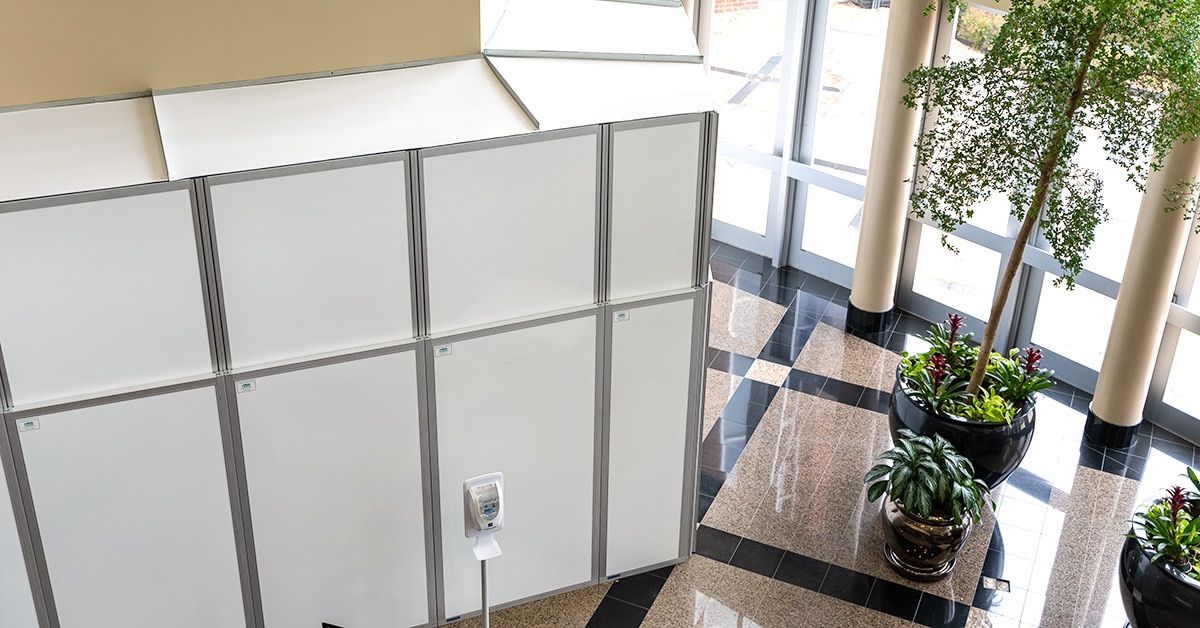
Maintaining cleanliness on a construction site is crucial, especially during renovations in sensitive environments like hospitals or data centers. The presence of dust and debris not only poses significant health and environmental risks but also fails to comply with OSHA (Occupational Safety and Health Administration) standards, which mandate the removal of excessive, easily dispersible dust.
Temporary Walls for Containing Dust and Debris
Addressing how to clean up drywall dust and debris starts with your plan for containing it. Plan ahead to include debris and dust management in the initial project phases. Here’s a breakdown of essential clean-up procedures:
- Ongoing Cleanup: Regular cleaning efforts throughout the day help mitigate the accumulation of harmful particles, reducing health risks and improving the air quality. This is especially critical in hospitals and similar settings, where dust can severely impact both patients and equipment.
- Daily Assignment of Cleanup Tasks: Organizational clarity is key. Assign specific cleanup duties to team members daily to ensure responsibility is clear and all areas are addressed, prepping the site for the next day’s work.
- Maintaining Clear Work Areas: Keeping work and walk areas free of obstructions like electrical cords and debris not only safeguards those on site but also enhances operational efficiency.
- Comprehensive Final Cleaning: At project completion, a thorough cleaning is imperative to leave a lasting positive impression on clients. This final effort should include sweeping, mopping, surface cleaning, and the removal of all construction barriers and materials.
See How Much You Can Save with STARC
Temporary Construction Walls Advance Sustainability
To further enhance environmental responsibility, sorting and recycling materials should be integral to the project workflow. Emphasizing the use of temporary wall systems not only facilitates easier cleanup but also significantly cuts down on waste, underscoring your commitment to sustainable building practices.
Advantages of Temporary Wall Systems in Construction
Using reusable temporary construction walls, or modular wall systems, provides a versatile and eco-friendly solution. These systems are ideal for maintaining cleanliness and order during construction, effectively controlling the spread of dust, debris and noise. Additionally, their reusability aligns with green building practices, providing both cost-efficiency and a significantly reduced environmental impact.
By adopting these strategic approaches, construction teams can achieve higher safety standards, better health conditions, and a cleaner, more sustainable environment. For more detailed strategies on reducing construction waste and implementing effective dust containment measures suitable for healthcare renovations, download the white paper below.
Understanding Environmental Considerations Before Executing an ICRA Protocol
Learn why and how to expand the scope of the environmental assessment when developing an ICRA protocol. Explore considerations to ensure effective containment.
Mentioned above are some basic ways to reduce dust and debris during renovation projects, and to minimize the negative impacts they cause. But what if there was a solution to containing dust, debris, noise, and other hazards to a work zone and protect the surrounding environment? With a premier temporary wall system like STARC’s, you can do just that while improving your company’s ROI and protecting your clients. Especially, if your business focuses on construction in sensitive work areas.
Improving Your Occupied Renovation Experience
Our temporary wall systems are ideal for projects in sensitive, occupied areas, including hospitals, airports, data centers, life sciences facilities, and more.
For example, contractors using our temporary wall systems in healthcare facilities can eliminate the dust, debris, and disruption associated with typical drywall containment. These noise-blocking temporary construction walls reduce jobsite noise by up to 50%. Plus, with proper installation, their simple lift-and-drop panel connection creates an airtight seal that exceeds ICRA Class IV/V requirements.
Our three-layer panel construction is rugged and highly durable, allowing the reusable panels to be used on hundreds of jobs. In addition, these temporary walls can be installed quickly and quietly, providing labor and material cost savings on project after project, year after year, virtually eliminating future costs associated with the containment of dust and debris.
Conclusion
Keeping your jobsite dust- and debris-free makes for a safer work environment and avoids setbacks in completing the job on time. To learn why the thinking around traditional containment methods is changing—and how more innovative temporary wall systems are improving project results across four key areas—check out our latest eBook, Rejecting Drywall’s ‘Hidden Costs’: Advancing Temporary Containment.
